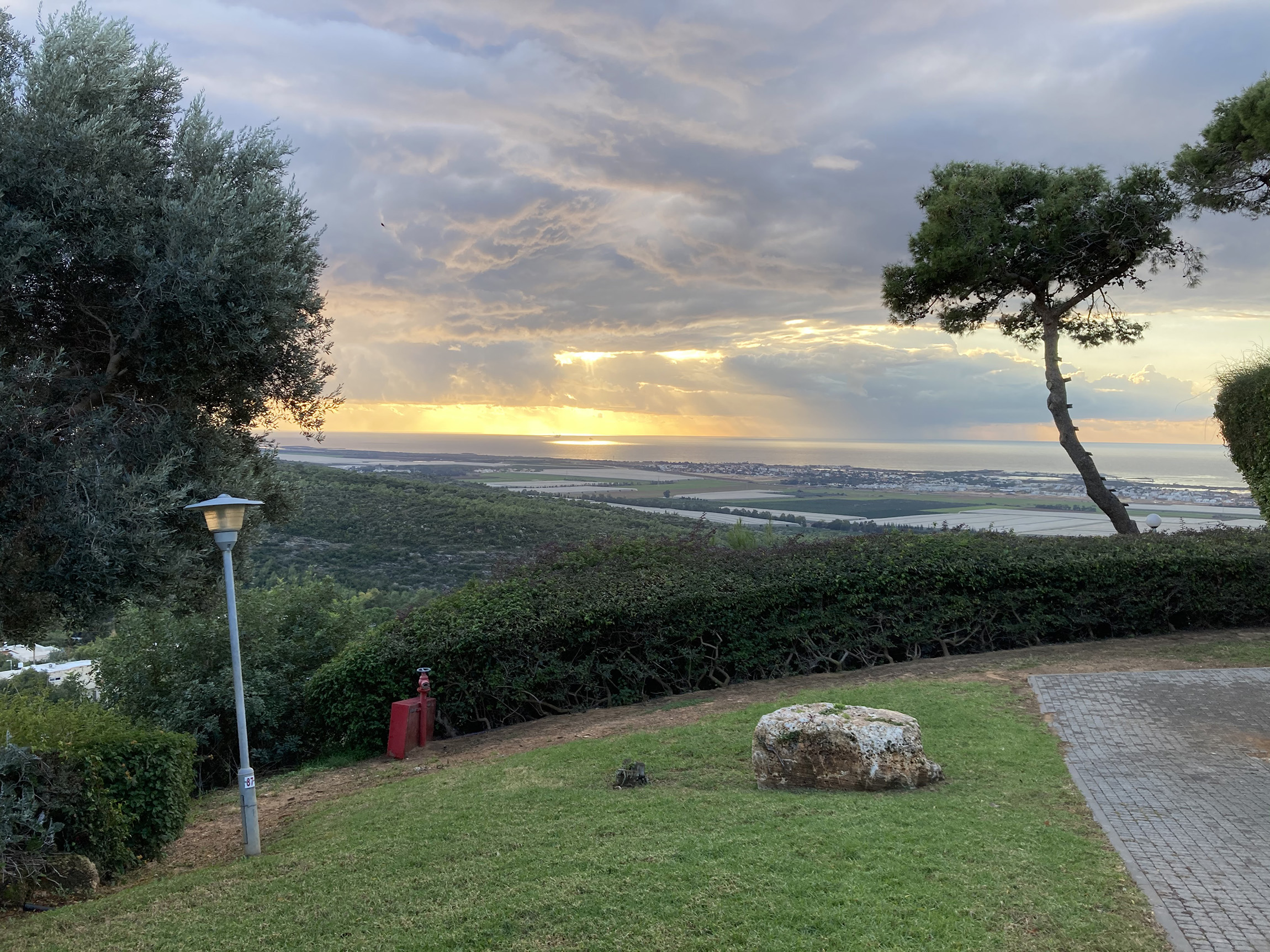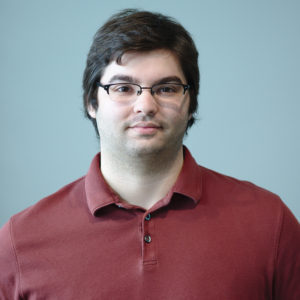Featured image: A view from the Yemin Orde youth village.
Part of the ongoing “Diaspora English” series, Daniel Crasnow reports on a year spent teaching in Israel during the coronavirus pandemic. You can read other Diaspora English articles here.
Haifa has a reputation as Israel’s most ethnically mixed city in part because of its modern industrious history. Temples sit next to Mosques and Churches, and “Happy Hanukkah”meets “Merry Christmas” when it’s the season. Haifa is constantly changing and evolving, contending with gentrification and a toxic national-political climate. Haifa finds its roots in a German colony, but this colony is now joined by communities of a variety of races and religions, who immigrated to the city as the Haifa port rose to prominence. Among them are the Baha’i Faith and the Ahmadiyya Muslim Community, both of whom call the city home. Immigrants from the former Soviet Union make up about a quarter of the city’s population and the Ethiopian Jewish Community constitutes a major population as well.
All of this has led to a general impression, as Haifa’s Deputy Mayor Mrs. Hedva Almog has said “if the state of Israel could conduct itself like the city of Haifa, things would be a lot better.” Haifa isn’t perfect – far from it. But the city’s reputation for rising to the challenges of diversity, and for envisioning a better future, has earned respect and admiration nation-wide.
Among these efforts is the Youth Village of Yemin Orde, just outside of Haifa. Known for its ground-up attempt to eliminate extreme poverty in Israel and beyond, the MASA Teaching Fellows program toured the place under the guidance of Racheli Yaso-Ngatuo, the Director of Visitor Relations and Outreach, a teacher and leader in the community who grew up in the Village herself. The learning community houses almost 430 students, most of whom are minorities and almost all of whom come from disadvantaged backgrounds. Some are local— from the poorest of Israel’s communities— while others arrived from around the world, with parents who sent their kids abroad to escape poverty back home.
The Village provides full-time care, schooling, tutoring, therapy, and other services. It is open 24 hours a day, 7 days a week, and 365 days a year. Even after graduating from the Village at age 19, most students retain their connection to the village for financial support, a secure home, and religious celebrations.
The Yemin Orde village includes a high school, a library, a dining hall, a synagogue, an art center, and sports facilities, all open for student use. There are also amazing views, as Yemin Orde sits at the top of Mount Carmel and looks out to the Mediterranean Sea.
Coronavirus lockdowns almost devastated the community. First, Israel ordered the Youth Village to close and its residents to return home. An appeal by Yemin Orde, among other Youth Villages, allowed some students to remain within the village. For the students with the most insecure home lives, this was a relief. In the pandemic, many students can’t afford to continue their studies at home, where spotty internet access makes Zoom lessons difficult at best. Many others come from abroad and can’t afford the travel expense. Still others don’t have a family or home to go back to.
Under this devastating social reality, Racheli guided us around Yemin Orde, and explained the situation. Racheli moved to Israel at age seven during Operation Moses, the Israeli military operation in 1984/1985 to bring Ethiopean Jews to Israel. She joined the Yemin Orde staff in 2008, and has continued staffing the camp through COVID-19. She lives on the Village grounds with her husband and her four sons.
As we toured the Village, Racheli recounted her experiences living at the Village, the staff members who changed her life. For Racheli, it was her House Mother, who she retained contact with long after her graduation. She told us what the Village tries to do for the many kids and teens that call it home. Yemin Orde provides housing, education, and community. It provides resources and tradition. It provides experience and responsibility, and for many, it provides hope.
“The kids talk a lot about their challenges. I’m a woman. I’m black. I’m an immigrant. I’m poor. And I shush them. I ask them ‘What is your dream?’ And many of them don’t know because they have always been focused on survival. They aren’t used to being able to look ahead.” Racheli said. “So I tell them, it’s like a road. You can’t talk about obstacles unless you know where you are going. If you are going to talk about road blocks and car crashes, you have to be driving somewhere.”
I come from an academic background. I am lucky enough to have always had food on the table, teachers to learn from, a home to go back to, and a million options for what I want my life to look like. My parents gave me that, through their own successes. And though they weren’t born with the same privileges I have, even this single generation of wealth has absolutely changed my view of the world and society around me.
I am lucky to be here, doing what I am doing. Between deals with the Israeli Government, MASA, and an outside scholarship I received, I am able to live for five months in the center of Tel Aviv, and another five months in Nazareth. I teach four days a week, work with BINA one day, and have another two days free. Right now, as I am writing this, I am on my break in school, at 10:40 AM on a Tuesday, and I am halfway through my workday today. I couldn’t be luckier.
What Racheli recognized, along with everyone who works at Yemin Orde, is that the ability to find fulfillment in life requires a semblance of a plan, and without a road map, one cannot properly contextualize, analyze, understand, and reflect on the struggles that brought us to this moment. Everyone understands that our struggles today build us, and make us better, for tomorrow. The pain we feel today may fade, and may become part of us. Our joy may etch itself into our psyche. Our successes and failures become our memories. But without the systematic social, educational, and economic structures in place to build an idea of where we want to go, it is impossible to have a plan for the future.
Wikipedia defines the Cycle of Poverty as “self-reinforcing mechanisms that cause poverty, once it exists, to persist unless there is outside intervention”. The tools necessary to get out of poverty require some financial means, but the deadly part of the Cycle of Poverty is that “impoverished individuals do not have access to economic and social resources as a result of their poverty”. For example, education can help people get out of poverty, but getting educated requires a commitment of money and, particularly, time, that most poor people are unable to sacrifice. Therefore, they remain poor, and the system reinforces itself.
I never quite understood how deeply that system reinforces itself, though. I had always assumed that some injection of financial capital would be able to break the cycle, but what Racheli pointed out to me is that the constancy of the Cycle of Poverty takes a mental and spiritual toll as well, and this toll has an extensive cost on the individuals who labor within the Cycle.
That is what Racheli is fighting against. It’s what Yemin Orde is fighting against. When Racheli says that her students can’t talk about road blocks without driving somewhere, I learned that in order for me to understand the obstacles in my life, I have to think about more than what I am doing day to day. I have to think about where I am going. I have to get past that obstacle, or at least imagine what the path looks like once that blockade is gone. It’s the only way to honestly see where I’ve been. The economic benefits Yemin Orde provides are absolutely necessary to assisting the residents of the village, but they are also insufficient. More than money and education, Yemin Orde provides a community, a family, and a home.

